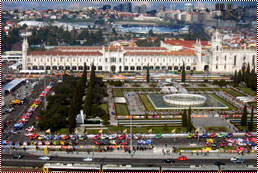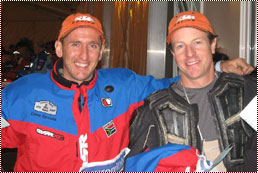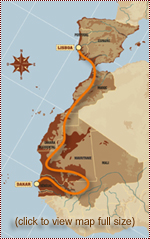 |          |  | ||
 | ||||
Race Reports
| ||||
|
03 Jan 2007 - Registration and Scrutineering In order to compete in the Dakar, you have to register and then you and your vehicle have to pass a technical inspection known as scrutineering. The point of the registration process is to make sure that you have all the necessary documents, approvals, permits, passes and information and that you have paid whatever money you owe the organization which in this case is the ASO. I probably should have put the money first in the previous sentence because without the organizers being satisfied that you have paid all that you owe, the rest of the process doesn't happen.
We pull up on the main avenue at the entrance to the Belem Center behind a line of BIG Kamaz and MAN trucks. These guys are the six-wheel drive monsters the just cruise across the desert. Originally, they were simply support vehicles for the the competitors. But they always ended up with a de facto race going on between the support vehicles so the Dakar added a truck category years ago. And these monsters are the competitors in that class. Sitting in the 4X4 F350, you can look out the window and stare at one of their wheel hubs. We slowly creep up the avenue to the entrance. We're next to go in and a Spanish team tries to jump the line. They're late and they're trying to make up for time so that they won't be fined for being late. The security guard is having none of it. He keeps telling them that they need to go to the rear of the line; they keep arguing and trying to push the car and 2 trucks ahead of us. Eventually, I complain to the guard who motions for me not to worry. A few minutes later, a real policeman shows up and orders the Spaniards out of the line. They leave. We go in next. There are at least 20 different stations that the competitors have to stop at (somewhat less for the assistance vehicle drivers) in order to complete the registration/administration process. They check the documents for the vehicle (vehicle registration, VIN number, vehicle dimensions and insurance). They check the documents for the person (passport, yellow fever card, driver's license). They issue the GPS equipment; they issue the boarding passes for the ferry to Morocco; they check our medical information; they check medical repatriation location; they check your personal medical insurance. They issue the route books and the infraction notebook (the notebook where they record every infraction committed by the service vehicle, ie. speeding). You slowly end up with a valise filled with assorted equipment and papers.
Before you can actually go to scrutineering you have to have your VHF radio, GPS and IriTrack connections tested and working. That's where our problems started. Steve Laroza's power to his IriTrack unit was not wired so that it was powered directly by the battery. It can't be fused or switched. The IriTrack is the device that warns race control if the unit shows that you have stopped for more than 3 minutes. There are problems if the unit goes off and there really isn't a problem so the organizers check to make sure that the competitors can't fool with the power to the device. So while the 45 minute clock is running Duane is madly rewiring Steve's bike. Our problems with the assistance truck start with the VHF radio and the IriTrack. We did not get all the cables for the installation before we left for Portugal so we are installing cables and debugging radios while we're waiting for our time to enter scrutineering. We get a lot of help from the IriTrack tech people and we eventually pass their tests and we get more stamps. By now it's 8:30 PM and we're late but we are on our way to scrutineering. The truck goes in to scrutineering without any problem. We were very worried about the height of the truck. So much so that we took the generator and the top rails off the truck so that it wouldn't be too high. In the end, they never checked. Down an aisle to have our number board and assorted sponsor decals put on. The official Dakar number plaques are pop riveted to the truck. We're getting closer.
We follow a bit later. Out to the photo stand for a picture of the truck and the 4 drivers in front. Big lights. Spectators at the fence blocking off the area. And then we're done and we're going to Africa, too. David drives out of the tech area and is surrounded by spectators taking pictures. The truck has been getting a lot of attention everywhere since it arrived. He creeps along and then lets loose with a blast from our air horn which can rupture eardrums. The crowd loves it. Steve's makes it through with no more problems. And then James, too. We're all out of scrutineering and the bikes are in Parc Fermé. Finally, 11 hours after we started we're done. Tired but thrilled. The whole process is really amazing. There must be hundreds of ASO personnel working to make all this happen. The atmosphere is very exciting. If you follow this event every year and this is your first time, the whole day is almost worth is just for the scrutineering. Bikes, small cars, big cars, small trucks and big trucks all being inspected, stamped and stickered. There's even an old French Duex Chevaux, the old 2CV, in line to go through scrutineering. I think that anyone trying to do this is a 2 CV needs good psychiatric help rather than good sponsorship but whatever. It's just such a thrill to be. Let the adventure begin. — Paul Dubinsky Animated map
More Race Reports to come Photos and video-diaries from Chris will uploaded during the race... Check back often!
| ||||
| Home | The Race | About Chris| The Team| The Bike | Race Reports | Supporters | Links | FAQs | Donate | Contact
| ||||
 | ||||
| Copyright © 2006 dakar101.com/Chris Jones. All Rights Reserved. Website by: MotorradMEDIA | ||||


 Chris is ready and has been for quite a while. The tension is up. He, Steve and Elmer leave for scrutineering at around 11:30 AM. We leave the hotel about 45 minutes late due to a last minute fuel tank change for James. He had put the brand new bike down during a training ride yesterday and he wanted to put a new tank on rather than risk a problem with this one. The problem was that the KTM parts trailer that was supposed to be open at 9:00 AM wasn't and that put the whole schedule behind. Finally, we're on our way also to the Belém Cultural Center where the Dakar is headquartered in Lisbon.
Chris is ready and has been for quite a while. The tension is up. He, Steve and Elmer leave for scrutineering at around 11:30 AM. We leave the hotel about 45 minutes late due to a last minute fuel tank change for James. He had put the brand new bike down during a training ride yesterday and he wanted to put a new tank on rather than risk a problem with this one. The problem was that the KTM parts trailer that was supposed to be open at 9:00 AM wasn't and that put the whole schedule behind. Finally, we're on our way also to the Belém Cultural Center where the Dakar is headquartered in Lisbon. After about a dozen stamps in the administration notebook and the mandatory GPS school, you're ready for the Final Check at which time you get a time card. The time card states what time you are required to present the vehicle for technical inspection or scrutineering at a certain time. If you're late, you get fined. They figure out that time by noting the time at the Final Check and adding 45 minutes. It's a nice plan but it doesn't work so smoothly in reality.
After about a dozen stamps in the administration notebook and the mandatory GPS school, you're ready for the Final Check at which time you get a time card. The time card states what time you are required to present the vehicle for technical inspection or scrutineering at a certain time. If you're late, you get fined. They figure out that time by noting the time at the Final Check and adding 45 minutes. It's a nice plan but it doesn't work so smoothly in reality. Meanwhile, Chris is moving right along. He's not having any problems. It's just taking a long time. I catch up with him again at a station where they are riveting his number bib to his racing jacket. He had just about gotten to the window to get his jacket done when the French Yamaha team showed up and jumped the line. Hmmm, French team, French event. Comme ci, comme ca. As soon as he gets his jacket done it's out of the garage area and to the photo stand for an official Dakar picture of Chris and his bike. Then out to Parc Fermé and it's done. He can't do anything to the bike from now until the start. He's going to Africa!
Meanwhile, Chris is moving right along. He's not having any problems. It's just taking a long time. I catch up with him again at a station where they are riveting his number bib to his racing jacket. He had just about gotten to the window to get his jacket done when the French Yamaha team showed up and jumped the line. Hmmm, French team, French event. Comme ci, comme ca. As soon as he gets his jacket done it's out of the garage area and to the photo stand for an official Dakar picture of Chris and his bike. Then out to Parc Fermé and it's done. He can't do anything to the bike from now until the start. He's going to Africa!